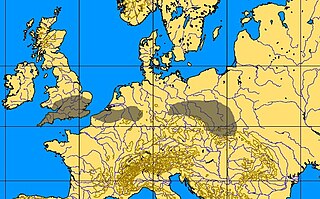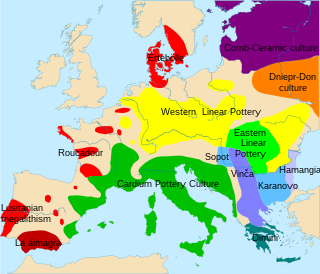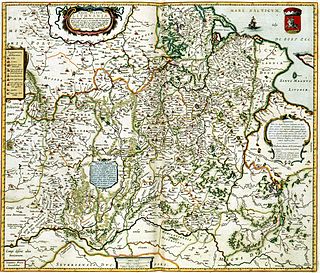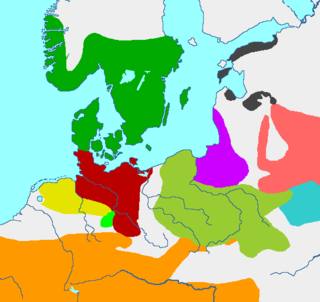 W
WThe Ahrensburg culture or Ahrensburgian was a late Upper Paleolithic nomadic hunter culture in north-central Europe during the Younger Dryas, the last spell of cold at the end of the Weichsel glaciation resulting in deforestation and the formation of a tundra with bushy arctic white birch and rowan. The most important prey was the wild reindeer. The earliest definite finds of arrow and bow date to this culture, though these weapons might have been invented earlier. The Ahrensburgian was preceded by the Hamburg and Federmesser cultures and superseded by the Maglemosian and Swiderian cultures. Ahrensburgian finds were made in southern and western Scandinavia, the North German plain and western Poland. The Ahrensburgian area also included vast stretches of land now at the bottom of the North and Baltic Sea, since during the Younger Dryas the coastline took a much more northern course than today.
 W
WThe Bromme culture is a late Upper Paleolithic culture dated to c. 11,600 to 9,800 cal BC, which corresponds to the second half of the Allerød Oscillation.
 W
WThe Corded Ware culture comprises a broad archaeological horizon of Europe between ca. 2900 BCE – 2350 BCE, thus from the late Neolithic, through the Copper Age, and ending in the early Bronze Age. Corded Ware culture encompassed a vast area, from the contact zone between the Yamnaya culture and the Corded ware culture in south Central Europe, to the Rhine on the west and the Volga in the east, occupying parts of Northern Europe, Central Europe and Eastern Europe. The Corded Ware culture is thought to have originated from the westward migration of Yamnaya-related people from the steppe-forest zone into the territory of late Neolithic European cultures such as the Globular Amphora and Funnelbeaker cultures, and is considered to be a likely vector for the spread of some or all of the core Indo-European languages, excluding the Anatolian languages and Tocharian.
 W
WThe Dębczyn culture is an archeological culture in Pomerania from the 3rd to 6th centuries. It was derived from the neighboring Wielbark culture with influences from the Elbe region. The culture was superseded as the result of the later migrations of West Slavs, in particular of the Pomeranians.
 W
WThe Funnel(-neck-)beaker culture, in short TRB or TBK was an archaeological culture in north-central Europe. It developed as a technological merger of local neolithic and mesolithic techno-complexes between the lower Elbe and middle Vistula rivers. These predecessors were the Lengyel-influenced Stroke-ornamented ware culture (STK) groups/Late Lengyel and Baden-Boleráz in the southeast, Rössen groups in the southwest and the Ertebølle-Ellerbek groups in the north. The TrB introduced farming and husbandry as a major source of food to the pottery-using hunter-gatherers north of this line.
 W
WThe Globular Amphora culture, c. 3400–2800 BC, is an archaeological culture in Central Europe. Marija Gimbutas assumed an Indo-European origin, though this is contradicted by newer genetic studies that show a connection to the earlier wave of Neolithic farmers rather than to invaders from the Ukrainian and western-southern Russian steppes.
 W
WThe Hamburg culture or Hamburgian was a Late Upper Paleolithic culture of reindeer hunters in northwestern Europe during the last part of the Weichsel Glaciation beginning during the Bölling interstadial. Sites are found close to the ice caps of the time. They extend as far north as the Pomeranian ice margin.
 W
WThe Jastorf culture was an Iron Age material culture in what are now north Germany and Denmark, spanning the 6th to 1st centuries BC, forming the southern part of the Pre-Roman Iron Age. The culture evolved out of the Nordic Bronze Age, through influence from the Hallstatt culture farther south.
 W
WThe Lengyel culture is an archaeological culture of the European Neolithic, centered on the Middle Danube in Central Europe. It flourished from 5000 to 4000 BC, ending with phase IV, e.g., in Bohemia represented by the 'Jordanow/Jordansmühler culture'. It is followed by the Funnel Neck Beaker/TrB culture. The eponymous type site is at Lengyel in Tolna county, Hungary.
 W
WLincombian-Ranisian-Jerzmanowician (LRJ) was a culture or technocomplex (industry) dating to the beginning Upper Paleolithic, about 43,000 years ago. It is characterised by leaf points made on long blades, which are thought to have been made by the last Neanderthals, although some researchers have suggested that it could be a culture of the first anatomically modern humans in Europe. It is rarely found, but extends across northwest Europe from Wales to Poland.
 W
WThe Linear Pottery culture is a major archaeological horizon of the European Neolithic, flourishing c. 5500–4500 BC. It is abbreviated as LBK, and is also known as the Linear Band Ware, Linear Ware, Linear Ceramics or Incised Ware culture, and falls within the Danubian I culture of V. Gordon Childe.
 W
WThe Lusatian culture existed in the later Bronze Age and early Iron Age in most of what is now Poland and parts of the Czechia, Slovakia, eastern Germany and western Ukraine. It covers the Periods Montelius III to V of the Northern European chronological scheme.
 W
WMaglemosian is the name given to a culture of the early Mesolithic period in Northern Europe. In Scandinavia, the culture was succeeded by the Kongemose culture.
 W
WThe Mierzanowice culture appeared in the area of the upper and middle basin of the Vistula, during the Early Bronze Age. It evolved from the so-called Proto-Mierzanowice cultural unit. The name of the culture comes from an eponymous site in Mierzanowice, where the cemetery was located. This entity was part of the pre-carpathian sphere epicorded cultures and it has been divided into three local groups: Samborzecka, Iwanowicka and Pleszowska. The initial phases of the culture are characterized by a small number of burials, seasonal settlements and single artifacts. The area of the Mierzanowice culture spread over from western Slovakia, through south - eastern Poland, reaching in the east the areas of the Volhynian Upland.
 W
WThe archaeological Neman culture existed from the 7th to 3rd millennium BC, starting in the Mesolithic and continued into the middle Neolithic. It was located in the upper basin of the Neman River. In the north, the Neman culture bordered the Kunda culture during the Mesolithic and the Narva culture during the Neolithic.
 W
WThe Nordic Bronze Age is a period of Scandinavian prehistory from c. 1700–500 BC.
 W
WThe Oksywie culture was an archaeological culture that existed in the area of modern-day Eastern Pomerania around the lower Vistula river from the 2nd century BC to the early 1st century AD. It is named after the village of Oksywie, now part of the city of Gdynia in northern Poland, where the first archaeological finds typical of this culture were discovered.
 W
WThe Pomeranian culture, also Pomeranian or Pomerelian Face Urn culture was an Iron Age culture with origins in parts of the area south of the Baltic Sea, from the 7th century BC to the 3rd century BC, which eventually covered most of today's Poland.
 W
WThe Prague-Korchak culture was an archaeological culture attributed to the Early Slavs. The other contemporary main Early Slavic culture was the Prague-Penkovka culture situated further south, with which it makes up the "Prague-type pottery" group. The largest part of sites dates to the late 5th and early 6th century AD according to Late Roman iron fibulae. Settlements were as a rule placed at rivers, near water sources, and were typically unfortified, with 8–20 households with courtyards. Burial sites were both flat graves and barrows (kurgans), and cremation was dominant.
 W
WThe Przeworsk culture was an Iron Age material culture in the region of what is now Poland, that dates from the 3rd century BC to the 5th century AD. It takes its name from the town Przeworsk, near the village where the first artifacts were identified.
 W
WThe Stroke-ornamented ware (culture) or (German) Stichbandkeramik, Stroked Pottery culture, Danubian Ib culture of V. Gordon Childe, or Middle Danubian culture is the successor of the Linear Pottery culture, a major archaeological horizon of the European Neolithic in Central Europe. The STK flourishes during approximately 4600-4400 BC. Centered on Silesia in Poland, eastern Germany and the northern Czech Republic, it overlaps with the Lengyel horizon to the south, and the Rössen culture to the west.
 W
WThe Swiderian culture is an Upper Palaeolithic/Mesolithic cultural complex, centred on the area of modern Poland. The type-site is Świdry Wielkie, in Otwock near the Swider River, a tributary to the Vistula River, in Masovia. The Swiderian is recognized as a distinctive culture that developed on the sand dunes left behind by the retreating glaciers. Rimantienė (1996) considered the relationship between Swiderian and Solutrean "outstanding, though also indirect", in contrast with the Bromme-Ahrensburg complex, for which she introduced the term "Baltic Magdalenian" for generalizing all other North European Late Paleolithic culture groups that have a common origin in Aurignacian.
 W
WThe Trzciniec culture is a Bronze-Age archaeological culture in East-Central Europe. It is sometimes associated with the Komariv neighbouring culture, as the Trzciniec-Komariv culture.
 W
WThe Tumulus culture dominated Central Europe during the Middle Bronze Age.
 W
WThe Únětice culture or Aunjetitz culture is an archaeological culture at the start of the Central European Bronze Age, dated roughly to about 2300–1800 BC. The eponymous site for this culture, the village of Únětice, is located in the central Czech Republic, northwest of Prague. There are about 1,400 documented Únětice culture sites in the Czech Republic and Slovakia, 550 sites in Poland, and, in Germany, about 500 sites and loose finds locations. The Únětice culture is also known from north-eastern Austria, and from western Ukraine.
 W
WThe Urnfield culture was a late Bronze Age culture of Central Europe, often divided into several local cultures within a broader Urnfield tradition. The name comes from the custom of cremating the dead and placing their ashes in urns which were then buried in fields. Over much of Europe, the Urnfield culture followed the Tumulus culture and was succeeded by the Hallstatt culture. Some linguists and archaeologists have associated this culture with the Proto-Celtic language, or a pre-Celtic language family.
 W
WThe Wielbark culture or East Pomeranian-Mazovian is an Iron Age archaeological complex which flourished on the territory of today's Poland from the 1st century AD to the 5th century AD.